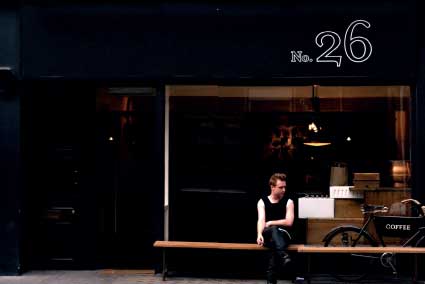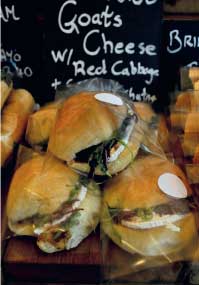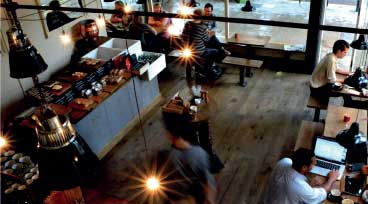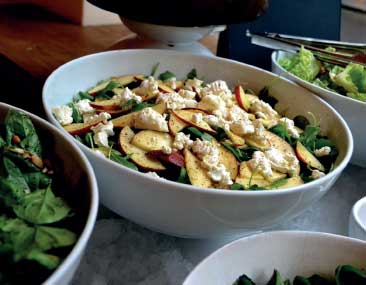Richard Lilley’s two outstanding London sandwich and café bars break one of the fundamental rules of marketing: there’s no branding. Customers are still flocking there in droves, however, as the news spreads by word of mouth, but guided by the address rather than the name.

Branding is as old as the hills. In the old days people used to leave behind a sign or a symbol to prove their ownership of a holding, or even to recognise powers.
In ancient Egypt the Pharaohs left behind a signature of theirs in the cast of hieroglyphs throughout their tombs, memorials and palaces.
Branding of animals was done by the ancient people of Norse with fired up iron, and it’s still done today by the cowboys of America.
It’s only recently that branding has evolved as a vital part of commerce. Product identification is nowadays vital to ensure that consumers are retained by companies and have confidence in them. Brand loyalty is woven through our multitude of daily decisions, from what toothpaste to clean our teeth with to what we eat at every meal. It’s now an intrinsic part of our western lives.
So what truly determines the success of a brand? Is it merely the attractive colour of the logo or the feel of it? Of course, it goes well beyond that, embracing the entire product, including the quality of service affiliated with it.
Good brand development carves the path to create the marketing plans, not to mention all the necessary steps to develop the product, simultaneously considering the taste and views of the consumer. But added to these challenges is the difficult pressure of the economy. So the question is where to begin from in order to establish the brand in the first place and where to pitch its commerciality and affordability.
 For me brands are my comfort blanket of innovation, style and quality. I am, to be honest, brand obsessed. It’s my personal choice that I hoover with a Dyson, spend half my life on an Apple Iphone and eat as many Crispy Kreme Doughnuts as I can reasonably get away with (bearing in mind I don’t eat carbs after midday).
For me brands are my comfort blanket of innovation, style and quality. I am, to be honest, brand obsessed. It’s my personal choice that I hoover with a Dyson, spend half my life on an Apple Iphone and eat as many Crispy Kreme Doughnuts as I can reasonably get away with (bearing in mind I don’t eat carbs after midday).
I won’t eat Ketchup unless it’s Heinz, or Mustard unless it’s Coleman’s. Green & Blacks is the only chocolate in the house. I have to use Domestos because I really do believe it kills more germs, knowing in my heart of hearts it probably doesn’t. I just don’t do own-label. Let’s face it, each and every one of us loves making choices based on the image of the brands that surround us. Something new and cool arrives and we all hanker after it. The more difficult it is to get it, the more we want it. There’s nothing like a waiting list to get us all going.
So, that said, can you even begin to imagine opening a new sandwich and coffee shop without even a name above the door? Not a printed napkin or sugar sachet in sight. An absolute non identity, except for the street number painted on the façade? Why would anyone in this current crazy financial climate even risk such a thing, let alone try and make a profit out of it.
So without further ado I’d like to introduce you to quite a clever man called Richard Lilley, if you haven’t already come across him.
Eighteen months ago Richard opened Tapped & Packed in Rathbone Street. No 26 to be precise, which you will need to know if ever you decide to pay a visit.
Richard doesn’t like brands. He tells me when I meet him that people are sick of having them pushed in their faces at every opportunity. Apparently he started all this as a result of a bet with his girlfriend, SJ who cuts a striking picture serving cakes behind the counter, her bright red hair curling under a very fetching grey bowler hat.

We are sitting in his second store at No 114 Tottenham Court Road at a wooden table on which sits a Tate & Lyle red Black Treacle tin, which houses the brown sugar and jars of Bonne Maman and Wilkins jams. Isn’t this branding? On the contrary these are mere props in what appears to be a slickly designed shop of the sharpest yet simplest style.
A tree trunk sits in the middle of a polished wooden floor, the counter is beaten metal, cream walls surround, all effortlessly chic. Not a commercial langar fridge in sight; instead drinks are chilled surrounded by crushed ice in old butler’s sinks. No tins, just bottles.
Customers come and go, many to sit on the bench outside and sip coffee in the autumn sunshine. A lady comes to sit on the bench next to me laden with probably the most good looking bowl of yoghurt near overflowing with wedges of fresh glistening pink grapefruit I think I have ever set eyes on. I am instantly jealous.
I am keen to learn from Richard what is at the heart of this café’s difference. Is it just another in the same mould as recent openings such as Fernandez & Wells and Kaffeine, all selling four hour rule unchilled products and great coffee?
Well clearly not. In eighteen months he’s turned the two into almost instant overnight profit and a third is on the way, all with no mention of a brand.
His ethos, he tells me, is to ‘achieve a higher standard of a standard thing’. My old embossed enamel coffee spoon is an example of what he means – a rather charming touch, and one of many that surround me.
 He shows me his drip coffee station built on the counter behind, which he designed – copper pipes supporting a row of V60 white china coffee filters, each one of which drips a perfect cup of coffee inside three minutes.
He shows me his drip coffee station built on the counter behind, which he designed – copper pipes supporting a row of V60 white china coffee filters, each one of which drips a perfect cup of coffee inside three minutes.
This is now his fifth highest seller behind Cappuccino, Latte, Americano and Flat White. He is outspoken and passionate about coffee and thinks the big guys are all about copying the ‘indies’; Costa is ‘shortening the gap’, Pret is ‘consistent but that’s it’
He thinks the British coffee market only has five years before the froth goes completely.
I am dying to ask him about food and try some. Something resembling the Mad Hatter’s tea party is being effortlessly put together on the other counter.
Piles of hand made, simply cellophane wrapped bloomers and baguettes are appearing, together with bowls and bowls of beautiful salads and row upon row of cakes.
Big and miniature hand frosted rustic cupcakes are piling up in droves.
One glance is all it takes to want it all. There are no labels to speak of, only simple informative signs with names and prices: poppy, carrot and chocolate marble cakes; beetroot, spinach and sunflower seed and peaches, goat’s cheese and rocket salads; cous cous with roasted veg, little gem lettuce with bacon and baby peas. The freshest, most delicious looking food is literally appearing everywhere.
 Today’s sandwiches include a roast chicken with lemon and thyme infused mayo on a ciabatta, a BLT on a brown bloomer, beef and horseradish, a brie, tomato and basil baguette. None of these are surprising but the bread is recognisable as outstandingly fresh and all have an impressive homemade look to their composition.
Today’s sandwiches include a roast chicken with lemon and thyme infused mayo on a ciabatta, a BLT on a brown bloomer, beef and horseradish, a brie, tomato and basil baguette. None of these are surprising but the bread is recognisable as outstandingly fresh and all have an impressive homemade look to their composition.
Everything is reasonably priced; sandwiches around the £3.00 mark, salads £2.00 – £4.00, cakes £2.50 a slice. I couldn’t complain and nobody does.
There simply isn’t enough of it all. Richard sells out as regularly as a heartbeat. He admits to a touch of arrogance, but I’d be the first to call it well justified.
I could sit here all day trying his food but decide to ask him to choose what he is most proud of. Without hesitation he says his tuna salad bloomer ‘because it’s the best’, and the carrot cake wins after a long discussion with SJ over which cake I should try.
They are both right. The tuna wins hands down as being just totally delicious. I know the recipe was put together with effortless skill, it just hits that bulls eye so often completely missed by the endless development and taste panels that are undertaken throughout our industry.
A tuna is the simplest of sandwiches, yet one that nine times out of ten is over-complicated and then fails miserably. As far as the carrot cake goes, I can’t even begin to describe its frosting, which is, well, just unbelievably good. You can tell it’s been made with zingy fresh orange juice and it just makes me want to smile.
 Many do this stuff and get it so wrong for so many reasons.
Many do this stuff and get it so wrong for so many reasons.
Richard admits he has a few secret weapons: his love of numbers, his Point One till system which he swears by and a ‘big butch Kiwi’ by the name of Mark who makes his awesome cakes.
His rules are simple: remain ‘saleable’ and ‘easy on ourselves’, always ‘work smart not fast’.
I ask him what gets him up in the mornings and he answers ‘exceeding expectations’. The first rule of show business, he says, is making it look easy. He’s certainly doing both and long may he continue.
